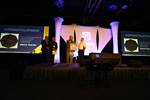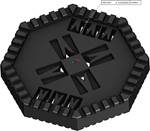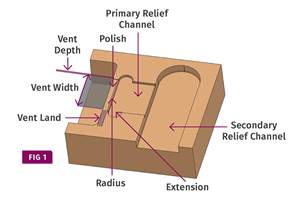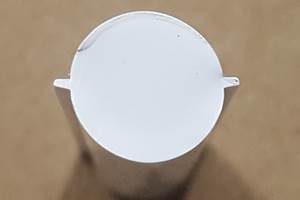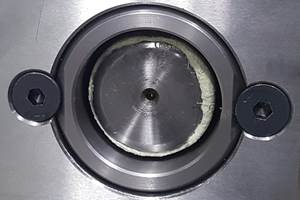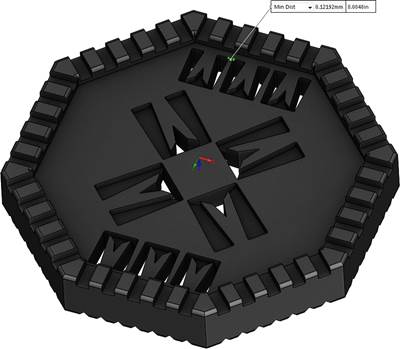There are four things you’re never far from at Matrix Tool: a journeyman tool and die maker, a degreed plastics engineer, some form of magnifying equipment, and family. The Fairview, Pa., moldmaker and injection molder celebrated its 50th anniversary in 2022, adapting and evolving over the five decades since David W. Lewis, Sr. and Robert D. Schuster first set up shop in the two-car garage of Lewis’s father-in-law in February 1972.
At that time, Lewis Sr. was 29 years old with four kids under the age of 8. Today he’s seated at a Matrix conference table reminiscing about the company’s early history and flanked by two of those “kids” as well as two grandsons. Although Lewis Sr. retired as company president in 2007, there are still eight Lewises employed at Matrix, including his sons Dave Jr., Tim and Greg; as well as their sons Dustin, Riley, Carson, Bailey and Tyler.
“My sons have been involved a long time, and they’ve done a great job—I have to say that,” Lewis Sr. says, thinking back to the boys’ earliest work cleaning up at the shop at 11 and 12 years old, not knowing they’d eventually make a career of Matrix. “My wife and I would say, ‘Oh boy, all these kids together, that’s not going work,’ but it’s worked out well. They’ve all gone in their own directions internally, and I think it’s helped the business tremendously.”
The three sons eventually became co-owners of Matrix and today Tim serves as president, with Dave Jr. and Greg, both journeymen tool and die makers, working as the v.p. of tooling/engineering and manager of the tooling division, respectively. Dave’s son Dustin and Greg’s son Tyler are also journeymen tool and die makers—the fifth generation of the Lewises to earn that distinction, going back to their great, great grandfather Lawrence “Leo” Lewis, born in 1887 and one of the founders of Berry Tool; and their great grandfather Gerald Lewis, who apprenticed at and eventually retired from Berry Tool.
Lewis Sr.’s introduction to the craft came in his grandfather Leo’s basement, being shown how to cut threads on a lathe and not fully understanding what he was looking at but being captivated nonetheless, as his grandfather changed the gears on the machine to change the threads, figuring out in his head what gears would turn which thread at which diameter. “It was incredible; I was in awe,” Lewis, Sr. says. “I was pretty young and didn’t totally understand the whole concept, but I knew it was a lot of hard work to do it.”
After high school, Lewis Sr. would join the U.S. Navy as a machinery repairman, working in a small machine shop aboard a ship, fabricating parts as needed, with his prior knowledge and experience giving him ample opportunities to learn more. “I was in a good position to do a lot of work that did some good on a ship,” Lewis Sr. says. “There was always some kind of need to machine something.”
Upon discharge, he went to work for his father, Gerald, now a tool and die maker, who had learned the craft from his grandfather and “could do almost anything, machine-wise,” according to Lewis Sr. “I knew when I got older that I wanted to follow suit somehow,” Lewis Sr. says, “maybe start my own business—I wasn’t sure at the time.”
After gaining experience at two Erie-based moldmaking operations, including an apprenticeship where he gained journeyman status, Lewis Sr. found himself at Plastek Industries’ precursor Triangle Tool, which counted industry legend Joe Prischak (creator of PT sister publication Moldmaking Technology) among its four founders. Fully committed to someday pursuing his own moldmaking business, Lewis Sr. relayed that aspiration to his new bosses, who not only didn’t object but actively helped him on the path to entrepreneurship. “The first thing I mentioned was that their place wasn’t going to be a permanent job for me—I did want to start my own business,” Lewis Sr. says, “and they supported that. I always appreciated the fact that they were open minded to my business development goals.”
Lewis Sr. and Schuster would quickly outgrow the garage, renting a new space and hiring their first full-time employee in 1973 before moving to the current location in 1976. Covering just over 2000 ft2, the one-time paint shop is still at the heart of Matrix today, with three of the original cinder-block walls visible and one hidden in drywall, as the company expanded around the original structure eight different times until reaching its current size of 60,000 ft2.
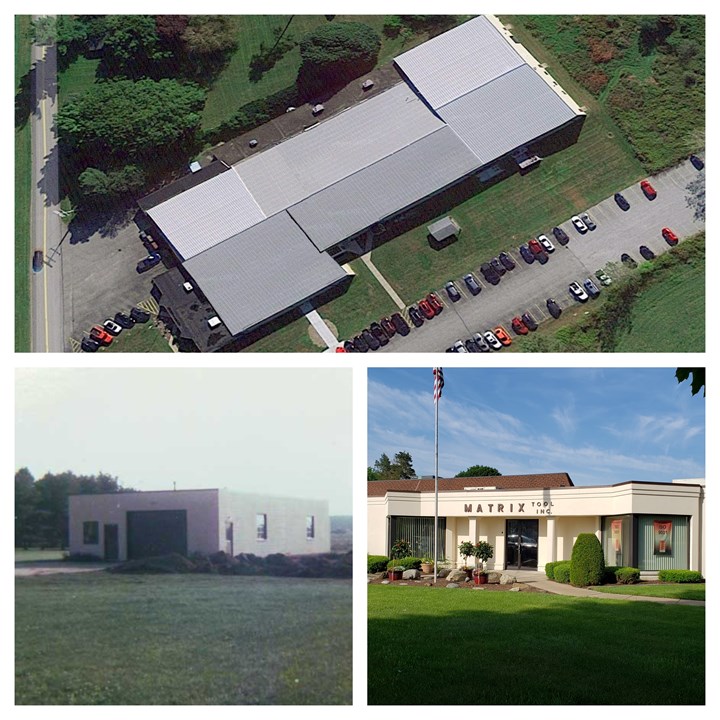
From humble beginnings as a former paint shop (lower left) covering just over 2000 ft2, Matrix Tool has expanded eight times to now cover (top) 60,000 ft2. (All photos: Matrix Tool)
In addition to space, the company added capabilities, notably injection molding, which began with one press for mold sampling in 1990, and today includes 40 machines ranging from 20 to 237 tons. Over time, they’ve also acquired all those aforementioned plastics engineering degrees to manage that business, including that of Carson Lewis, Lewis Sr.’s grandson, and one of numerous employees to earn the plastics engineering technology degree at nearby Penn State Behrend. The company has 13 degreed plastics engineers on staff, almost 10% of its total workforce.
Today all that moldmaking and plastics expertise comes together to take on jobs that arrived at Matrix’s door because no one else said it was possible; or a competitor said it was possible but failed to make it a reality; or a customer that has already seen what Matrix is capable of is sending it return business. The difficulty of the jobs, and specifically the micro parts or micro features on parts and tools, are why you’re always within a few steps of a microscope, magnifying glass or digital measurement device at Matrix.
Ever Finer Requirements
In its early molding days, it was Matrix’s work with former General Motors division Delphi that pushed it into the rarified echelon of precision toolmaking and molding it inhabits today. “In the electrical connectors industry, the features got smaller, the connectors got smaller, the spacing between circuits got smaller, and they got more detailed,” explains Tom Moyak, director of business and engineering development at Matrix. “That meant that in steel, everything kept shrinking and shrinking and shrinking and getting finer in size, tighter in tolerance. That led to us pushing the limits of what everyone would consider to be a very good molding machine or very good equipment and tooling.”

Matrix Tool’s dedicated micromolding space runs 10 Sodick Plustech injection molding machines, eight of which have identical setups for seamless processing.
To Moyak’s point, in the last two years its toolmaking operation has added an AgieCharmilles Cut 2000S wire EDM and AgieCharmilles High Speed Mikron 500 LP mill, along with a High-Speed Sodick UH650L Mill and a high-precision Sodick AG40LP Die Sinker EDM. The dual-wire EDM does a “rough cut” with a 0.004-in.-thick wire, and finishes with a 0.002-in.-thick wire, which is half the thickness of a sheet of paper. The new high-speed mill offers 42,000-rpm spindle speed and optical linear scales on the X, Y, and Z axes with a measuring step of just 20 nanometers.
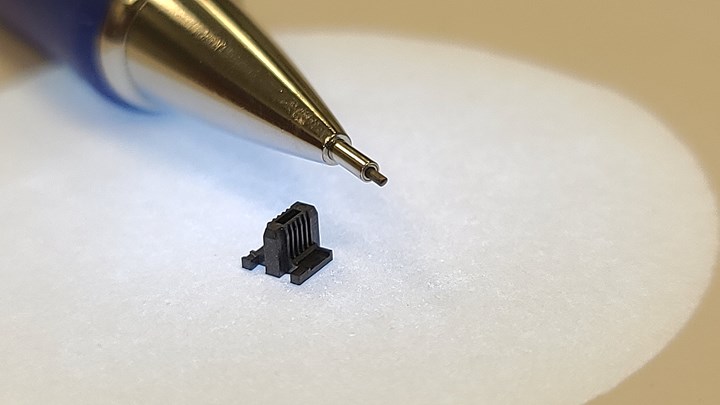
This microconnector is representative of the precision molding and precision tools that Matrix takes on regularly.
On the molding side, it led the company to purchase its first Sodick press in 2014, utilizing that machine’s two-stage plunger injection unit and hybrid direct clamping unit for greater precision. Since then, Matrix Tool has added 10 more 20-ton Sodick’s which occupy its second micro-focused molding room. That space was converted from storage in 2014 and expanded by 1500 ft2 in 2018. Of the 10 Sodick’s in that room, eight are identical, so Matrix can drag and drop jobs with minimal setup changes.
“We’ve found that we can treat them all as one machine—literally one process per mold,” Moyak says. “That process can be transferred electronically to another machine while we physically move the mold, and it can start up without adjustment. If an adjustment is ever needed—maybe 2-5% of the time—it’s usually an incredibly small adjustment.”
Heart of the Tooling Department
Lewis Jr. calls Matrix’s EDM area, which includes six CNC wire EDMs and nine CNC and die-sink EDMs, the “heart” of the company’s tooling department, noting that every mold Matrix makes, whether its shipped off or run in-house, requires the fine detail made possible by EDM. At the heart of the “heart” is Tony Pecorella, who manages the Wire EDM department. When he completed his apprenticeship at age 19, he was the youngest ever to earn his journeyman tool and die making card in Pennsylvania. Stationed at the newest wire EDM, Pecorella’s workspace includes a microscope and a drawer full of custom fixtures, designed and made in-house since off-the-shelf models don’t offer the precision or capabilities Matrix requires when cutting steel on such a minute scale. “Plus or minus one thou,” Lewis Jr. comments rhetorically on the tolerances quoted by catalog fixtures, “that’s a mountain of off for us.”
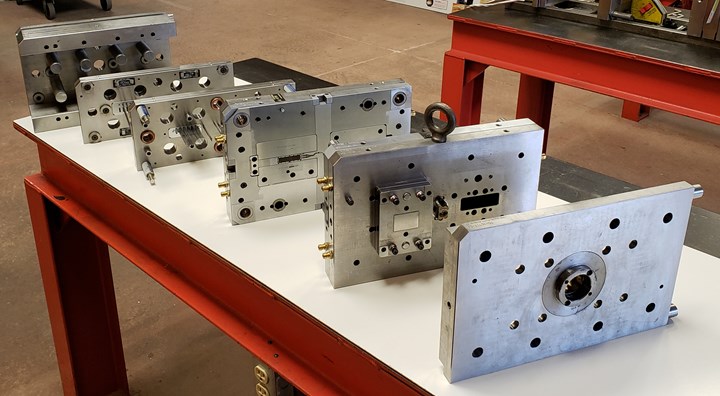
Matrix Tool has made its own mold bases and frames for decades, extending the precision of its cavities to the entire mold system.
It's not just fixturing that Matrix has decided to build internally to meet its production accuracy requirements. The company has built its own mold bases and frames for decades, and more recently started making robot grippers and end-of-arm-tooling (EOAT) for certain automation jobs. If it could, Matrix would apply its expertise and know-how to everything it needs, says Greg Lewis, tooling division manager. “In a perfect world, we’d prefer not to send anything out, because we’d have control over it. We know what we’re doing and what we’re looking for and expecting.”
Standardize, Right-size and Eliminate Variation
That knowledge of what they want has led Matrix to standardize on equipment as much as possible: Nissei and Sodick molding machines, Yushin robots, Advantage temperature controllers, and RJG cavity pressure equipment. Matrix uses RJG sensors and its Decoupled III molding approach to control its processes, whereas others might just use it for monitoring. Instead of switching its processes over from filling to packing at a predetermined setpoint, Matrix uses RJG technology to make the shift based on what’s happening inside the cavity—cavity pressure vs. screw position.
“Once you learn to set up a process to do a Decoupled III,” Moyak says, “even if you don’t have sensors, you can still set the process the same way, and that’s kind of where we differentiate ourselves a little bit.” The use of RJG sensing technology and standardizing on equipment has allowed Matrix to target molding’s biggest challenge: variability.
“When you have the engineering expertise, the tooling expertise, the whole gamut that we have,” Moyak says, “we can take a holistic look at the whole process and be able to understand where we can remove waste and variability.”
In addition to attacking variability, Matrix targets inefficiency using a process it calls right sizing. Whether that’s right sizing physical space via equipment layout and material storage or rightsizing a tool down to its cavitation and runner length, the company seeks to maximize productivity. “A lot of the high-precision tools we have right now are intricate cavity units that fit in larger mold frames requiring larger tonnage presses. We continue to correctly size them in downsized frames and ultra high-precision cavity units that run in smaller, more accurate machines. This allows Matrix to reduce waste by using less material in a runner and save the customer a lot of money, but to do so you have to reduce your flow length by bringing your cavities closer, which allows you to make smaller runner channels. There are ways to be creative in doing that.”

“Rightsizing” molds can lead to smaller tools with greater output at Matrix.
Matrix works to exploit the breadth and depth of its knowledge, putting toolmakers on the molding floor while also applying their expertise as mold designers. “You design better tools if you’ve built them,” Lewis Jr. says. There’s also a degreed plastics engineer in the mold repair and conditioning room, bringing a molding perspective to mold maintenance. That cross-pollinated knowledge is brought to bear on what Moyak describes as the company’s creative approach to new designs, which often challenge long-held molding and moldmaking paradigms, requiring some faith in each other and from their customers.
“We frequently come up with very creative solutions for molding challenges, ones where we agree—we’ve never seen this done before in tooling or molding. If it makes sense, we explain it to our customers,” Moyak says. “They have faith in us, and we go forward as a team in agreement—we hit home runs together this way. Once we prove ourselves to customers, they see the value and come back for repeat business.”
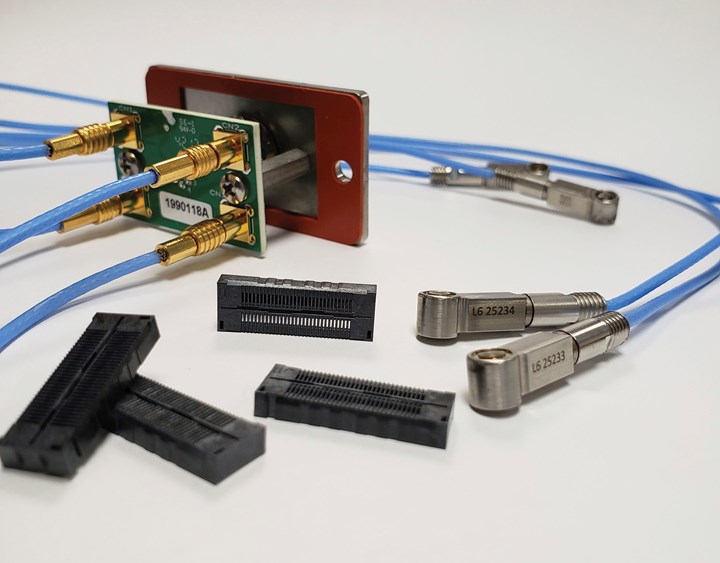
RJG sensor technology makes precision connector molding possible at Matrix Tool.
Family Matters
There have been plenty of home runs over Matrix’s 50 years in business, and Lewis Sr. knows what ultimately makes such success possible: “You can’t do the job unless you have the right people. It ends up that they’re your biggest asset in the long run; that’s all it is. With good people, you get good results. Treat people fairly, and they’ll do the job for you.”
More than just fairly, Matrix strives to treat its people like family. When you enter the company, you’re greeted with a wall of 5 x 7 in. framed photographs, with wooden letters spelling out “The Matrix Family” above them. Following the custom established by Lewis Sr., photographs of all newly hired Matrix employees are added the the wall.
Families celebrate together, and that was case when Matrix marked its golden anniversary. Starting in September 2021, the company gave away $1000/week to employees via a bi-weekly, attendance-based lottery, with names drawn by by different team members, including Lewis Sr. himself, from a raffle drum. Over the 50 raffles, the company had 43 winners, including two of Lewis Sr.’s grandsons, with five lucky employees winning twice, and one very lucky employee winning three times.
“I can’t tell you how far that went with the employees,” Lewis Jr. says, “they appreciated it, especially in these times with Covid and the economy and everything.”
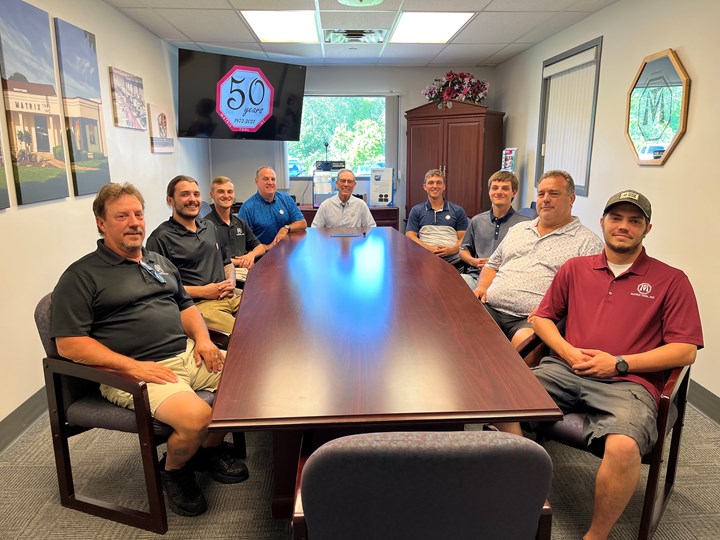
Three generations of the Lewis family are pictured here, with eight currently working at the company. L–R: Dave Jr., Tyler, Riley, Tim, Dave Sr., Carson, Bailey, Greg and Dustin.
Related Content
How to Mount an Injection Mold
Five industry pros with more than 200 years of combined molding experience provide step-by-step best practices on mounting a mold in a horizontal injection molding machine.
Read MoreBack to Basics on Mold Venting (Part 2: Shape, Dimensions, Details)
Here’s how to get the most out of your stationary mold vents.
Read MoreWhere and How to Vent Injection Molds: Part 3
Questioning several “rules of thumb” about venting injection molds.
Read MoreWhat You Need to Know About Leader Pins and Bushings
There’s a lot more to these humble but essential mold components than you might suspect. Following the author’s tips could save much time, money and frustration.
Read MoreRead Next
Matrix Tool Wins Inaugural Hot Shots Competition
The Pennsylvania-based injection molder and moldmaker applied its tooling know how and Sodick injection technology to take home both Hot Shots prizes.
Read MoreMatrix Tool Sweeps 'Hot Shots' Competition
Working together with injection machine builder Sodick Plustech, this Pennsylvania molder and moldmaker won both prizes in Plastics Technology’s first-ever Hot Shots injection molded parts competition, held at Molding 2021.
Read MoreTiny Part Showcases Big Molding, Moldmaking Capabilities
Grab a magnifying glass and check out this entrant in Molding 2021’s Hot Shots injection molded part competition.
Read More


